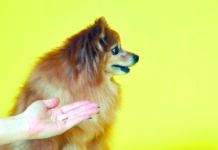If you already brush your dog’s teeth once a day, you’re way ahead of the curve. Too many people don’t, and it paves the way for gum disease that can both eventually make a dog lose teeth and contribute to or complicate serious diseases. That’s because bacteria in a mouth that never gets cleaned can make their way into the bloodstream and from there to far-flung body tissues that may become infected. Here are five tips for making each daily tooth-brushing session more effective.
- Angle the brush to hit the spot where the teeth meet the gums. A lot of people focus just on the white part — the enamel. That’s important, but food has a way of sliding off the enamel on its own. It’s the tooth/gum juncture that’s tricky and where so much of dental disease takes place. (That’s true for people, too.)
- Make sure to get the back teeth. That’s the location of a dog’s main chewing teeth
and therefore the ones where dental disease very often occurs. - Concentrate your efforts on the outside of the teeth rather than the inside. The inside has more contact with saliva, which contains chemicals that attack the film of plaque clinging to dogs’ teeth and gums. Bonus: Brushing the outsides of the teeth is easier than reaching for the insides.
- If you use toothpaste (which is not strictly necessary because just the mechanical action of the brushing will do a lot), look for ingredients with the suffix “ase,” which is chemistry shorthand for “enzyme.” The enzyme will help disrupt the layer of plaque. Among the most common enzymes in canine toothpaste: lactoperoxidase. (Never use a toothpaste made for people. The dog will swallow the fluoride, which is bad for her.)
- If your dog doesn’t like a toothbrush coming at her, gauze wrapped around your finger will work. She might enjoy the feeling of having her gums massaged.






I give a tiny treat after each tooth brushed